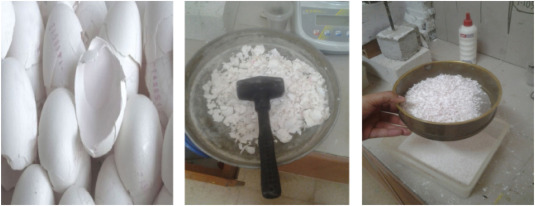
EFFECTS OF EGGSHELL POWDER AS PARTIAL REPLACEMENT OF CEMENT ON FLEXURAL BEHAVIOR OF ONE-WAY CONCRETE SLABS
EFFECTS OF EGGSHELL POWDER AS PARTIAL REPLACEMENT OF CEMENT ON FLEXURAL BEHAVIOR OF ONE-WAY CONCRETE SLABS
Assist Lect. Dhifaf N. Hamadallah
College of Engineering / University of Anbar
This research investigated the effect of eggshell powder as a partial replacement of cement on flexural behaviour of a one-way concrete slab. First cement was partially replaced with eggshell powder at these percentage 0%, 3 %, 5 %, 8%, 10%, 13% and 15% (by weight of cement). The resulting concrete was compared for mechanical properties (density, compressive and flexural strength). The best three percentages of replacement that improved mechanical properties compared to reference mix without replacement were adopted to cast one-way slabs, which were tested under four-point flexural test to investigate the behaviour of concrete slabs, contain eggshell powder. The Scanning Electron Microscope (SEM) test was made to study the microstructure of concrete and also explain the results. The obtaining results indicated the advantage of incorporation of eggshell powder in concrete. The concrete unit weight has not obviously affected by eggshell powder content. The 3% eggshell powder gives the highest compressive and flexural strength of about 51% and 4.9% respectively than the reference one. The Scanning Electron Microscope analysis shows that the structure of samples incorporating eggshell powder is denser than the microstructure of the reference sample. For one-way slab specimens, at 3% and 5% ESP, the specimen’s fails at larger loads and smaller deflection compared to reference one. While concrete containing 8% ESP showed a gradual increase in the deformation capacity for a given load and its behaviour was closed to reference one.

From this research, results one can conclude that the incorporation of ESP into concrete has the following effects:
- A slight difference in the density was noticed for all ESP mixes compared with reference mix maximum about 3%, which can be neglected.
- An increase in the compressive was noticed for ESP up to 8% by about 51%, 28.9% and 8.9% for 3%, 5% and 8% ESP respectively. For ESP content more than 8% a decrease in the compressive was noticed with increasing of ESP content by 15.6%, 28.9 and 42.2% for 10%, 13% and 15% ESP respectively.
- In addition, an increase in flexural strength was noticed for the replacement of ESP up to 8% by 4.9%, 3.1% and 2.9% for 3%, 5% and 8% ESP respectively. While the ESP content of more than 8% caused a decrease in the flexural strength by 8.2%, 14.7% and 22.4% for 10%, 13% and 15% ESP respectively.
- The maximum load recorded from slab test under bending at failure decreased with increasing of ESP content.
- The maximum deflection at failure is increasing with increasing of ESP content.
- Also because of the high content of calcium carbonate in ESP, which can act as inert filler within the concrete, the concrete with ESP has less porous microstructure for ESP up to 8%.



.png)